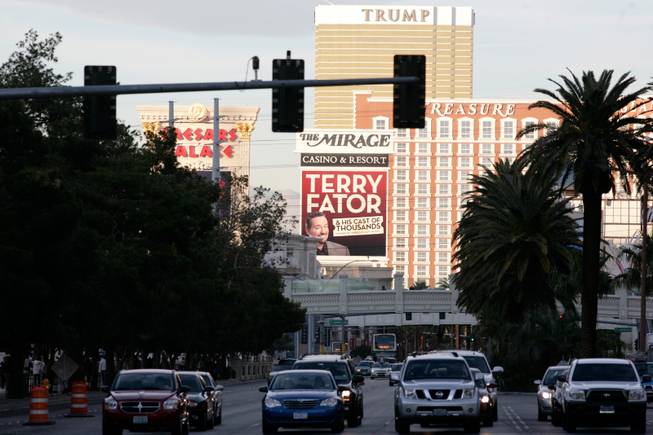
Revenue fell at Strip casinos last fiscal year while corporate expenses rose. Profit fell 57 percent as a result.
Tuesday, Jan. 27, 2009 | 2 a.m.
Gaming Control Board annual reports
Sun Archives
- Annual report shows dramatic fall of casino profits (1-16-2009)
- Research firm expects further declines in gaming market (1-15-2009)
- Caesars Palace delays opening of tower (1-12-2009)
- Strip gaming win lowest in five years (1-9-2009)
The cost of doing business on the Strip has skyrocketed, with casinos attempting to lure customers with more discounts and freebies amid a worsening economy, according to the Gaming Control Board’s annual report on the industry.
The report suggests that Strip customers spent more on food and rooms and less on just about everything else, including gambling and drinking.
Revenue fell by nearly a percentage point at Strip casinos, while the properties’ corporate expenses rose 19 percent during the fiscal year that ended June 30, compared with the same period a year earlier. Profit fell 57 percent as a result.
The figures partly reflect the recession, which worsened in the latter half of last year. And yet, they also include results from some of the strongest quarters in recent memory, including the last two quarters of 2007 and the first quarter of 2008, when the effects of the souring national economy had yet to be widely felt in Las Vegas.
A spectacular boom immediately preceded last year’s national recession and epic tourism decline on the Strip. Casinos initiated significant cost-cutting strategies by mid to late 2008 — initiatives that aren’t necessarily reflected in the Control Board’s Gaming Abstract.
Released this month, the report aggregates figures for the Strip’s 40 casino license-holders generating revenue of at least $1 million a year. This year’s report includes the Palazzo, which opened in January 2008 next to the Venetian, and a small unidentified casino that broke the million-dollar threshold for the first time.
The Gaming Control Board declined to name the casino. By law, gaming revenue figures for individual casinos are confidential.
Interest on $22.6 billion in debts soared 33 percent from last fiscal year, to $1.6 billion. The debts, including mortgages, bonds and short-term notes, ballooned 87 percent from fiscal 2007.
Strip casinos’ return on invested capital was a meager 6.7 percent in fiscal 2008, down from 9.5 percent a year earlier. That figure — which has historically been in the mid-teens on the Strip — is calculated by dividing profit and interest expenses by the value of assets minus money owed.
Strip casinos’ overhead costs rose even as corporate payroll declined. Payroll for company officers plummeted 19 percent, while payroll for other corporate-level employees fell 3 percent.
Music and entertainment costs rose 101 percent and energy costs rose 7 percent.
Department-level results, which included casino, rooms, food and beverage, mostly worsened as expenses rose faster than revenue.
Interestingly, the food departments in Strip casinos — which generated about $373 million in revenue in fiscal 2008 — reported an 89 percent increase in profit as revenue rose and costs fell.
Some casino operators were mystified by those results, which include casino-owned restaurants and revenue from third-party operators.
Some cheaper restaurants such as fast food chains have benefited as consumers seek bargains amid the recession — though the Strip’s biggest moneymakers aren’t its cheapest eats. A more reasonable explanation from these operators seems to be the fact that the 2008 fiscal year includes strong business results from late 2007, which led to higher menu prices.
The food department was the only one in which Strip-wide payroll costs rose for both officers and other employees. Department-level payroll costs mostly declined. Employee benefits fell across all departments, while officer-level payroll fell in all departments with the exception of food. For other workers besides officers, payroll rose in the casino, rooms and food departments and fell in the beverage department, which is listed separately.
Other highlights on Strip casinos included in the report:
• In the casino department, profit fell 9 percent on a 3 percent decline in revenue despite a 7 percent drop in gaming taxes and licensing costs. Bad debt expenses — uncollectable gambling debts that are written off — rose 4 percent. The cost of comps for gamblers rose 3 percent despite the economy. Strip casinos’ comped expenses were 25 percent of gaming revenue, up from 24 percent a year earlier. The average slot machine won $123.74 from gamblers on a per-room, per-day basis, up a percentage point from a year ago. The average casino floor is nearly 72,000 square feet, a 4 percent decline from a year earlier.
• In the rooms department, profit fell 3 percent on a decline in revenue of less than a percentage point. The cost of complimentary rooms rose 13 percent. Average room rates rose 2 percent to $149. Average room occupancy was 94 percent compared with 95 percent a year earlier.
• In the food department, profit rose 89 percent on a 7 percent increase in revenue. The cost of comped meals rose 15 percent. Average food sales per hotel room per day rose 9 percent to $89.97.
• In the beverage department, profit fell 12 percent on a 7 percent decline in revenue. The cost of comped drinks rose 15 percent. Beverage sales per room, per day, fell 5 percent on average.

Join the Discussion:
Check this out for a full explanation of our conversion to the LiveFyre commenting system and instructions on how to sign up for an account.
Full comments policy